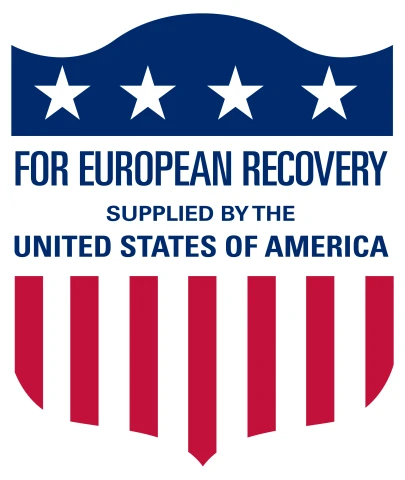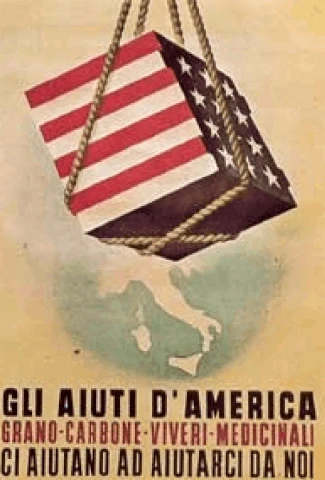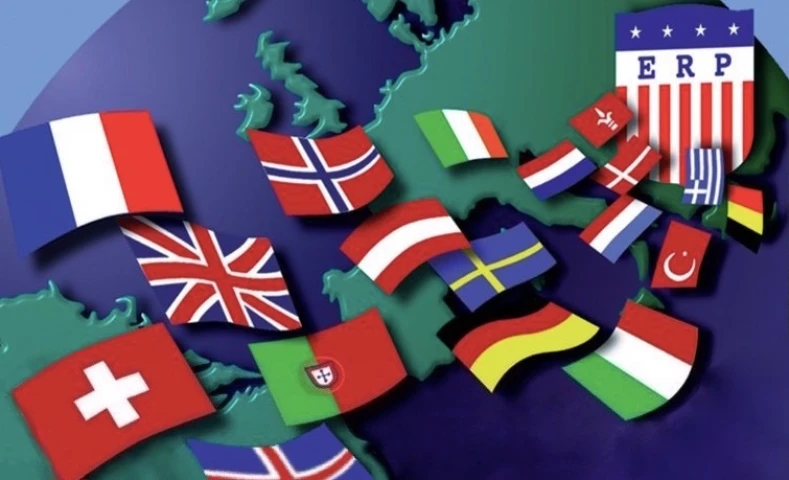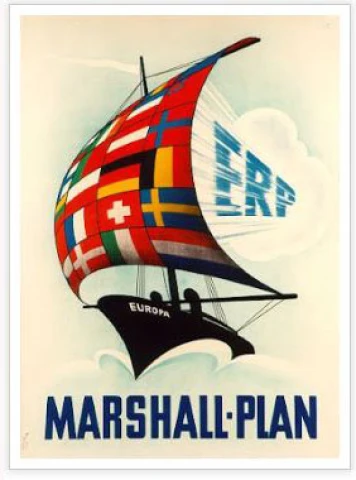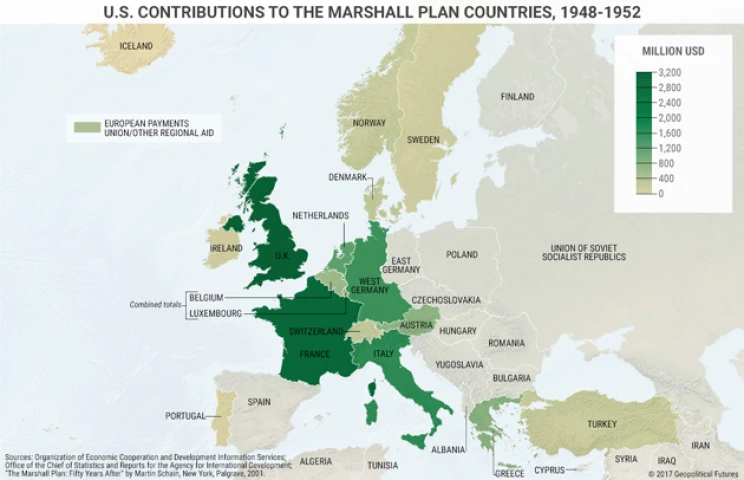In these dangerous and tiring days, when the two countries we all love are the most affected in the world by this horrendous virus, many of us look with concern at what will happen when the health emergency will be over, or at least mitigated. It will be a very difficult time, our economies are and will be hard hit. Many people have compared the period ahead of us with the post-war period.
To give a message of hope, We the Italians thought to tell how Italy has come out of the Second World War: we have already overcome a terrible period, we will do it again. But we can never forget that in order to recover, then, we were helped by our American friends, who with the Marshall Plan gave decisive help to the whole of Western Europe.
We would like to thank Professor Michela Giorcelli, one of the Italians born here whose talent has also been recognized by the United States: she teaches economics at the Department of Economics of the University of California, and one of the topics she is an expert on is the Marshall Plan. It will not be easy but we will succeed, the relationship between Italy and the United States will become even stronger, and everything will be fine (andrà tutto bene).
Professor Giorcelli, you published a dissertation entitled “Economic Recovery and the Determinants of Productivity and Innovation: Evidence from Post-World War II Italy”. Also, together with Prof. Nicola Bianchi, an assistant professor in the Strategy Department at Kellogg School of Management and a faculty research fellow at the National Bureau of Economic Research, you have a paper entitled “Reconstruction Aid, Public Infrastructure, and Economic Development: The Case of the Marshall Plan in Italy”. Why did you choose this specific topic for your research?
I chose this topic for my research for two reasons: one is to better understand the Italian economic development during the 50s and the 60s and the other one is to answer a more general economic question.
On the first point, after World War II Italy experienced the so-called economic miracle with GDP growth of 6 percent per year. Historians have long associated this growth with the aid that Italy received through the Marshall Plan. Our research aims at quantifying the role that the Marshall plan played in Italian economic development after World War II.
On the second point, the Marshall Plan and the Italian case can be seen as a unique opportunity to study the effect of foreign aid on economic development. Today, foreign aid is one of the most popular form of aid for developing countries, but assessing its effectiveness is challenging mostly due to lack of long-term data. So, in this case evidence from economic history will help us to understand what the long-term effects of economic aid on a country’s development and growth are. Moreover, the Marshall Plan grouped together different types of aid, allowing us to study the impact of different types of aid on economic development.
In both your papers you address the fundamental role of the Marshall Plan on Italian Post World War II recovery. First of all, what was the Marshall Plan and why Italy was involved in it?
The Marshall Plan was an economic and financial program sponsored by the United States between 1948 and 1952 with the goal of helping western and southern Europe recover from World War II. Still today it is considered the largest foreign aid program ever experienced in the world; it accounted 5% of the American GDP in 1948 (which in terms of Italian GDP is roughly 2.5% of each year between 1948 and 1952).
The United States invited European countries to participate into the program: the participation was on a voluntary basis, so it was ultimately a decision of each country. To give an example, the plan was also offered to Eastern Europe that however refused it. Beyond its economic aspect, the Marshall Plan also had a strong political motivation. The American idea was to use economic aid to prevent the spread of the Communism that was a serious threat: the years 1946 and 1947 counted many strikes organized by the Communist party throughout all Western Europe. The United States helped European countries to have them on their side at the dawn of the Cold War.
In fact, while the Marshall Plan was specifically directed to Europe, there were also other programs for Asian countries such as Japan, to prevent Chinese expansion in that area.
Your first dissertation we mentioned is about, and I use your own words, “the economic development of Italy that, between the late 1940s and the early 1970s, moved from being a war-ravaged agricultural country to the seventh most industrialized power of the world.” How exactly the Marshall Plan helped Italy?
The Marshall Plan provided different types of aid to Italy. In the early 1948, it mostly transferred in-kind subsidies like food, medications and raw materials because of the World War II shortage. The majority of aid that Italy received between the end of 1948 and 1952 was composed of “reconstruction grants”, given to the Italian government to rebuild infrastructures that were damaged during World War II. In these five years a small part of money transfer was in form of loans to large Italian firms.
Starting 1952, the United States sponsored an additional program called “technical assistance and productivity program”. While the Marshall Plan until then had focused on rebuilding and increasing Italian production, in this second phase it aimed at increasing the productivity of Italian firms. To do so, the United States organized managerial training trips for Europeans managers at American firms and also granted loans to small and medium sized Italian firms in order to buy machineries produced in the United States.
Can you tell us more about this aid to productivity and technology?
The transfer of managerial knowledge had a large and persistent effect on firms performance: firms whose managers participated in the training trips in the United States were more likely to survive, and had higher sales, employment, and productivity that not participating companies. Those effects persisted for at least 15 years after the program. By contrast, firms that purchased new machineries from the United States improved their performances but only in the short run. The effects were smaller in magnitude and did not persist over the time, as in the case of the firms which did the managerial training trip.
With this respect, we can say that the Marshall Plan contributed to the provision of a managerial capital that, back then, most of European countries were lacking: and the lack of managerial capital is still a problem today in most countries, even in the developed world.
For instance, since the middle 1990s productivity growth in Southern Europe has been substantially lower than in other developed countries. Research conducted by Professors Schivardi and Schmitz argues that this lower productivity growth has been partially caused by inefficient manager practices which limited Southern Europe’s gains from the IT Revolution. A similar point is also made by Professors Pellegrino and Zingales with specific reference to Italy. Professors Bloom, Sadun and Van Reneen explain that the increasing of productivity gap between Europe and United States starting in 1995 is due to the adoption of information technologies by American multinationals, which are “better” managed. So, still today there are active research and debates about the role that managerial capital has on the industrial activity and more in general on firm’s performance. The Marshall Plan was pioneering this type of transfer from more developed to less developed countries.
Did the Marshall Plan help all Italian provinces in the same way?
The Marshall Plan aid was allocated largely based on the Italian provinces need of infrastructure’s reconstruction after World War II. Infrastructure’s damages were, in turn, strongly related to the exposure to the war and bombing, especially after the armistice in 1943. The armistice marked a change in the type of bombing that Italy was exposed to, in the sense that the Allies started bombing infrastructures and specifically roads, rail roads and bridges with the goal of preventing German troupes stuck in Italy to go back to Germany. So, as a result, war damages and aid were concentrated more north of the Gothic line (the last major line of defence along the summits of the northern part of the Apennine Mountains in the Italian region Emilia Romagna) where the conflict lasted longer.
However, in the same region, different provinces were exposed differently to bombing episodes and, therefore, they received different amount of Marshall Plan grants after World War II.
How can we summarize the conclusions that you and Professor Bianchi came to about the benefit that Italy got from the American Marshall Plan money
The Marshall Plan had positive effects on Italian provinces’ economic development as it is demonstrated by our study, which shows that provinces which received more reconstruction grants through the Marshall Plan not only rebuilt their infrastructure network, but were also able to redesign and modernize it. This modernization affected the provinces’ agricultural and industrial outcomes. Provinces that received more aid increased their agricultural production between 10 and 20% for all major crops, and we think that more efficient infrastructure network allowed farms to sell their products on a larger market.
Moreover, we also observe an increase in the technology adopted in the agricultural sector: specifically there was a strong increase in the number of tractors and this is strongly related to the Marshall Plan, because these type of machines had been widely used in the US agricultural sector right before World War II.
Finally, we document structural changes in the labour market: employment in the agricultural sector dropped by more than 20% and these workers were absorbed by the industrial and service sectors. Moreover, in the industrial sector there was an increase in the number of firms, especially small-sized ones (i.e., firms with less than 10 employees): we think that the more efficient infrastructure network attracted new firms which decided to locate close to it.
So, we can conclude that the Marshall Plan had a positive direct effect on the Italian post World War II economic miracle. In fact, two of our main findings - the technology adoption in agricultural sector and the shift of employment from the agricultural to the industrial and service sector - were the two main characteristics of the Italian post World War II economic development phase.
However, the Marshall Plan did not reduce the pre-existing regional inequalities: southern provinces which were less developed than northern ones were less exposed to bombing after 1943, therefore received less aid from the Marshall Plan.
Professor, you live in Los Angeles, where you teach economics at the University of California. When the nightmare of the coronavirus ends, Italy will find itself in a situation that, according to many people, already has some similarities with the one it was in after the Second World War. But there can be no new Marshall Plan from America. What do you think Italy has to do to get up and grow again? Are we going to make it?
For sure, Italy is facing an extremely hard moment and the number of countries which are involved in the current crisis, including the US themselves, may recall a world war. However, I think that there are important differences between these two events.
First of all, the general widespread destruction that was there after World War II is not going to be there this time: Italy will still have its production capacity, its infrastructure’s network, and will be able to rely on a much more specialized labour-force than after World War II. In this respect, I think that even without any foreign aid, the recovery from this crisis will be easier and faster than it was after World War II.
However, I think that in this situation, management could and should play an important role in pushing the country recover. In my view, this crisis may represent an opportunity to modernize managerial structure, reorganize production in order to adapt faster to a changing world (and part of this change will be driven by the crisis itself), and finish the still uncomplete IT revolution in all the sectors of the economy: health, education, industry, services. For sure, if these changes are made, they will give us huge productivity gains in the future and this will definitely help Italy recover and start growing again. And, as it always happens in Italian history, I’m sure that even this time we will make it! Italians are fantastic, especially in hard times!
How do you see the future of the relationship between Italy and the United States after the end of this crisis?
I expect the relationship between Italy and the United States to become stronger than ever after this crisis. Since the aftermath of World War II, Italy and United States have built a strong economic relationship. The United States have been one of our major trading partners, especially for the “made in Italy” exports.
But there is much more than that. Italy and the United States have promoted an intense scientific and cultural collaboration, ranging from academic research and climate change challenges to student exchange, art, tourism, and food. Old migration at the beginning of the 20th century has melted with the current one. This relationship will not be harmed by the current crisis. Conversely, after its end, the restart of these exchanges will be crucially important to help economic recovery, with mutual benefits for both countries.
In questi giorni pericolosi e stancanti, in cui i due Paesi che tutti noi amiamo sono quelli più colpiti al mondo da questo orrendo virus, molti di noi guardano con preoccupazione a cosa succederà quando l’emergenza sanitaria sarà terminata, o almeno attenuata. Sarà un periodo molto difficile, le nostre economie sono e saranno duramente colpite. In tanti hanno paragonato il periodo che ci aspetta a quello dell’ultimo dopoguerra.
Per dare un messaggio di speranza, We the Italians ha pensato di raccontare come l’Italia è uscita dalla seconda guerra mondiale: abbiamo superato un periodo tremendo, lo faremo anche con questo. Ma non possiamo mai dimenticare che per risollevarci, allora, siamo stati aiutati dai nostri amici americani, che con il Piano Marshall diedero un aiuto determinante a tutta l’Europa occidentale.
Ringraziamo dunque la Professoressa Michela Giorcelli, una degli italiani nati qui il cui talento è stato riconosciuto anche dagli Stati Uniti: insegna economia presso l’Università della California a Los Angeles, e uno dei temi di cui è esperta è proprio il Piano Marshall. Non sarà facile ma ce la faremo, il rapporto tra Italia e Stati Uniti diverrà ancora più forte, e andrà tutto bene
Professoressa Giorcelli, lei ha pubblicato uno studio dal titolo “Economic Recovery and the Determinants of Productivity and Innovation: Evidence from Post-World War II Italy” (La ripresa economica e i fattori determinanti della produttività e dell'innovazione: testimonianze del secondo dopoguerra in Italia). Inoltre, insieme al Prof. Nicola Bianchi, professore presso il Dipartimento di Strategia della Kellogg School of Management e ricercatore presso il National Bureau of Economic Research, sta per pubblicare un altro studio dal titolo "Reconstruction Aid, Public Infrastructure, and Economic Development: The Case of the Marshall Plan in Italy" (Aiuti alla ricostruzione, infrastrutture pubbliche e sviluppo economico: il caso del Piano Marshall in Italia). Perché ha scelto questo specifico argomento per i suoi studi?
Ho scelto questo argomento per due motivi: il primo è per capire meglio lo sviluppo economico italiano degli anni '50 e '60; il secondo è per rispondere a una domanda economica più generale.
Sul primo punto, dopo la seconda guerra mondiale l'Italia ha vissuto il cosiddetto miracolo economico con una crescita del Pil del 6% all'anno. Gli storici hanno da tempo associato questa crescita agli aiuti che l'Italia ha ricevuto attraverso il Piano Marshall. La nostra ricerca mira a quantificare il ruolo che il Piano Marshall ha avuto nello sviluppo economico italiano dopo la seconda guerra mondiale.
Sul secondo punto, il Piano Marshall e il caso italiano possono essere visti come un'opportunità unica per studiare l'effetto degli aiuti esteri sullo sviluppo economico. Oggi l'aiuto estero è una delle forme di aiuto più popolari per i paesi in via di sviluppo, ma la valutazione della sua efficacia è impegnativa soprattutto per la mancanza di dati a lungo termine. Quindi, in questo caso le prove della storia economica ci aiuteranno a capire quali sono gli effetti a lungo termine degli aiuti economici sullo sviluppo e sulla crescita di un paese. Inoltre, il Piano Marshall ha raggruppato diversi tipi di aiuti, permettendoci di studiare l'impatto dei diversi tipi di aiuti sullo sviluppo economico.
In entrambi i vostri lavori affrontate il ruolo fondamentale del Piano Marshall sulla ripresa del secondo dopoguerra italiano. Prima di tutto, cos'era il Piano Marshall e perché l'Italia vi era coinvolta?
Il Piano Marshall era un programma economico e finanziario promosso dagli Stati Uniti tra il 1948 e il 1952 con l'obiettivo di aiutare l'Europa occidentale e meridionale a riprendersi dalla Seconda Guerra Mondiale. Ancora oggi è considerato il più grande programma di aiuti all'estero mai sperimentato al mondo; nel 1948 rappresentava il 5% del PIL americano (che in termini di PIL italiano è circa il 2,5% di ogni anno tra il 1948 e il 1952).
Gli Stati Uniti invitarono i paesi europei a partecipare al programma: la partecipazione era su base volontaria, quindi è stata alla fine una decisione di ogni paese. Per fare un esempio, il piano è stato offerto anche all'Europa dell'Est, che però lo ha rifiutato. Oltre all'aspetto economico, il Piano Marshall aveva anche una forte motivazione politica. L'idea americana era quella di utilizzare gli aiuti economici per prevenire la diffusione del comunismo che rappresentava una seria minaccia: gli anni 1946 e 1947 videro molti scioperi organizzati dal partito comunista in tutta l'Europa occidentale. Gli Stati Uniti aiutarono i Paesi europei ad averli dalla loro parte all'alba della guerra fredda.
Infatti, mentre il Piano Marshall era diretto specificamente all'Europa, c'erano anche altri programmi per i Paesi asiatici come il Giappone, per impedire l'espansione cinese in quell'area.
La sua prima tesi di cui abbiamo parlato riguarda, e uso le sue stesse parole, "lo sviluppo economico dell'Italia che, tra la fine degli anni Quaranta e l'inizio degli anni Settanta, è passata dall'essere un Paese agricolo devastato dalla guerra alla settima potenza più industrializzata del mondo". In che modo esattamente il Piano Marshall ha aiutato l'Italia?
Il Piano Marshall ha fornito diversi tipi di aiuti all'Italia. All'inizio del 1948, a causa della penuria della seconda guerra mondiale, trasferì per lo più sussidi in natura come cibo, medicinali e materie prime. La maggior parte degli aiuti che l'Italia ricevette tra la fine del 1948 e il 1952 era costituita da "aiuti alla ricostruzione", concessi al governo italiano per la ricostruzione delle infrastrutture danneggiate durante la Seconda Guerra Mondiale. In questi cinque anni una piccola parte del trasferimento di denaro fu sotto forma di prestiti alle grandi imprese italiane.
A partire dal 1952, gli Stati Uniti sponsorizzarono un programma aggiuntivo chiamato "programma di assistenza tecnica e produttività". Mentre il Piano Marshall fino ad allora si era concentrato sulla ricostruzione e sull'incremento della produzione italiana, questa seconda fase mirava ad aumentare la produttività delle imprese italiane. Per fare ciò, gli Stati Uniti organizzarono viaggi di formazione manageriale per manager europei presso aziende americane e concessero anche prestiti a piccole e medie imprese italiane per l'acquisto di macchinari prodotti negli Stati Uniti.
Può dirci di più circa questi aiuti a produttività e tecnologia?
Il trasferimento di conoscenze manageriali ebbe un grande e persistente effetto sulle prestazioni delle aziende: le aziende i cui manager parteciparono ai viaggi di formazione negli Stati Uniti ebbero maggiori probabilità di sopravvivere, e conseguirono maggiori vendite, occupazione e produttività rispetto alle aziende non partecipanti. Questi effetti durarono per almeno 15 anni dopo il programma. Al contrario, le aziende che acquistarono nuovi macchinari dagli Stati Uniti migliorarono le loro prestazioni, ma solo nel breve periodo. Gli effetti furono di minore entità e non proseguirono nel tempo, come invece nel caso delle aziende che fecero i viaggi di formazione manageriale.
A questo proposito, possiamo dire che il Piano Marshall ha contribuito a mettere a disposizione un capitale manageriale che allora mancava nella maggior parte dei Paesi europei: e la mancanza di capitale manageriale è ancora oggi un problema nella maggior parte dei Paesi, anche nel mondo sviluppato.
Ad esempio, dalla metà degli anni '90 la crescita della produttività nell'Europa meridionale è stata sostanzialmente inferiore a quella di altri paesi sviluppati. Una ricerca condotta dai professori Schivardi e Schmitz sostiene che questa minore crescita della produttività è stata in parte causata da pratiche manageriali inefficienti che hanno limitato per l'Europa meridionale i vantaggi provenienti dalla rivoluzione informatica. Un'osservazione analoga è stata fatta anche dai Professori Pellegrino e Zingales con specifico riferimento all'Italia. I professori Bloom, Sadun e Van Reneen spiegano che l'aumento del divario di produttività tra Europa e Stati Uniti a partire dal 1995 è dovuto all'adozione delle tecnologie informatiche da parte delle multinazionali americane, che sono "meglio" gestite. Così, ancora oggi sono attive ricerche e dibattiti sul ruolo che il capitale manageriale ha sull'attività industriale e più in generale sulla performance dell'impresa. Il Piano Marshall è stato pioniere di questo tipo di trasferimento dai Paesi più sviluppati a quelli meno sviluppati.
Il Piano Marshall ha aiutato tutte le province italiane allo stesso modo?
Gli aiuti del Piano Marshall sono stati stanziati in gran parte sulla base delle necessità di ricostruzione delle infrastrutture delle province italiane dopo la seconda guerra mondiale. I danni alle infrastrutture erano, a loro volta, fortemente legati all'esposizione alla guerra e ai bombardamenti, soprattutto dopo l'armistizio del 1943. L'armistizio segnò un cambiamento nel tipo di bombardamento a cui l'Italia fu esposta, nel senso che gli Alleati iniziarono a bombardare le infrastrutture e in particolare strade, ferrovie e ponti con l'obiettivo di impedire alle truppe tedesche bloccate in Italia di tornare in Germania. Così, di conseguenza, i danni di guerra e gli aiuti si concentrarono più a nord della linea gotica (l'ultima grande linea di difesa lungo le cime della parte settentrionale dell'Appennino emiliano romagnolo) dove il conflitto durò più a lungo.
Tuttavia, nella stessa regione, diverse province furono esposte in modo diverso ai bombardamenti e, quindi, ricevettero diverse sovvenzioni del Piano Marshall dopo la seconda guerra mondiale.
Come possiamo riassumere le conclusioni che lei e il professor Bianchi avete tratto dal beneficio che l'Italia ha ottenuto dai soldi americani del Piano Marshall
Il Piano Marshall ha avuto effetti positivi sullo sviluppo economico delle province italiane, come dimostra il nostro studio, che dimostra che quelle che hanno ricevuto maggiori contributi per la ricostruzione attraverso il Piano Marshall non solo hanno ricostruito la loro rete infrastrutturale, ma hanno anche potuto riprogettarla e modernizzarla. Questa modernizzazione ha influito sui loro risultati agricoli e industriali. Le province che hanno ricevuto più aiuti hanno aumentato la loro produzione agricola tra il 10 e il 20% per tutte le principali colture, e pensiamo che una rete di infrastrutture più efficiente abbia permesso alle aziende agricole di vendere i loro prodotti su un mercato più ampio.
Inoltre, si osserva anche un aumento della tecnologia adottata nel settore agricolo: nello specifico, c'è stato un forte aumento del numero di trattori e questo è fortemente legato al Piano Marshall, perché questo tipo di macchine era stato ampiamente utilizzato nel settore agricolo statunitense subito prima della seconda guerra mondiale.
Infine, documentiamo i cambiamenti strutturali del mercato del lavoro: l'occupazione nel settore agricolo diminuì di oltre il 20% e questi lavoratori furono assorbiti dal settore industriale e dai servizi. Inoltre, nel settore industriale ci fu un aumento del numero di imprese, soprattutto di piccole dimensioni (cioè con meno di 10 dipendenti): pensiamo che la rete infrastrutturale più efficiente abbia attratto nuove imprese che hanno deciso di localizzarsi vicino ad essa.
Possiamo quindi concludere che il Piano Marshall ha avuto un effetto positivo diretto sul miracolo economico italiano del secondo dopoguerra. Infatti, due dei nostri principali risultati - l'adozione della tecnologia nel settore agricolo e lo spostamento dell'occupazione dal settore agricolo a quello industriale e dei servizi - sono state le due caratteristiche principali della fase di sviluppo economico italiano del secondo dopoguerra.
Il Piano Marshall non ha però ridotto le disuguaglianze regionali preesistenti: le province meridionali meno sviluppate di quelle settentrionali sono state meno esposte ai bombardamenti dopo il 1943 e quindi hanno ricevuto meno aiuti dal Piano Marshall.
Professoressa, lei vive a Los Angeles, dove insegna economia all'Università della California. Quando l'incubo del coronavirus finirà, l'Italia si troverà in una situazione che, secondo molti, ha qualche somiglianza con quella del secondo dopoguerra. Ma non ci potrà essere un nuovo Piano Marshall dall'America. Cosa pensa che debba fare l'Italia per rialzarsi e crescere di nuovo? Ce la faremo?
Sicuramente l'Italia sta affrontando un momento estremamente difficile e il numero di Paesi coinvolti nella crisi attuale, compresi gli stessi Stati Uniti, potrebbe ricordare una guerra mondiale. Tuttavia, penso che ci siano importanti differenze tra questi due eventi.
Innanzitutto, la distruzione generale e diffusa che c'è stata dopo la seconda guerra mondiale non ci sarà questa volta: l'Italia avrà ancora la sua capacità produttiva, la sua rete di infrastrutture, e potrà contare su una forza lavoro molto più specializzata rispetto al secondo dopoguerra. A questo proposito, penso che anche senza aiuti dall'estero, la ripresa da questa crisi sarà più facile e veloce di quanto non sia stata dopo la seconda guerra mondiale.
Tuttavia, penso che in questa situazione, il management potrebbe e dovrebbe svolgere un ruolo importante per spingere il paese a riprendersi. A mio avviso, questa crisi può rappresentare un'opportunità per modernizzare la struttura manageriale, riorganizzare la produzione al fine di adattarsi più velocemente ad un mondo che cambia (e parte di questo cambiamento sarà guidato dalla crisi stessa), e finire la rivoluzione informatica ancora incompiuta in tutti i settori dell'economia: sanità, istruzione, industria, servizi. Sicuramente, se questi cambiamenti saranno realizzati, ci daranno enormi guadagni di produttività in futuro e questo aiuterà sicuramente l'Italia a riprendersi e a ricominciare a crescere. E, come sempre accade nella storia italiana, sono sicura che anche questa volta ce la faremo! Gli italiani sono fantastici, soprattutto nei momenti difficili!
Come vede il futuro del rapporto tra Italia e Stati Uniti dopo la fine di questa crisi?
Mi aspetto che il rapporto tra Italia e Stati Uniti diventi più forte che mai dopo questa crisi. Dall'indomani della seconda guerra mondiale, l'Italia e gli Stati Uniti hanno costruito un forte rapporto economico. Gli Stati Uniti sono stati uno dei nostri principali partner commerciali, soprattutto per le esportazioni del Made in Italy.
Ma c'è molto di più. L'Italia e gli Stati Uniti hanno promosso un'intensa collaborazione scientifica e culturale, che va dalla ricerca accademica e dalle sfide del cambiamento climatico allo scambio di studenti, all'arte, al turismo, all'alimentazione. La vecchia migrazione dell'inizio del XX secolo si è fusa con quella attuale. Questo rapporto non sarà danneggiato dalla crisi attuale. Al contrario, dopo la sua fine, la ripresa di questi scambi sarà di fondamentale importanza per aiutare la ripresa economica, con benefici reciproci per entrambi i Paesi.



